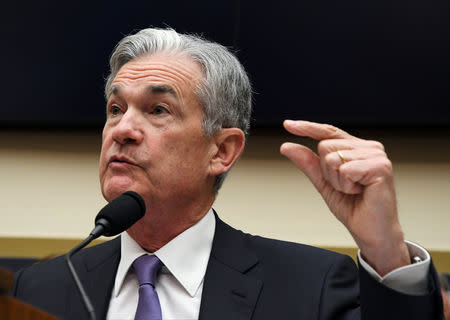Fed's Powell between a rock and hard place - Ignore the yield curve or tight job market?

By Howard Schneider
WASHINGTON (Reuters) - Unemployment near a 20-year low screams at the U.S. Federal Reserve to raise interest rates or risk a too-hot economy. The bond market, not far from a state that typically precedes a recession, says not so fast.
The decision of which to heed looms large when the Fed's interest-rate setters meet next week. Which path they follow will begin to define whether Chairman Jerome Powell engineers a sustained, recession-free era of full employment, or spoils the party with interest rate increases that prove too much for the economy to swallow.
New Fed staff research and Powell's own remarks seem to put more weight on the risks of super-tight labour markets, which could mean a shift up in the Fed's rate outlook and a tougher tone in its rhetoric.
Goldman Sachs economists, for instance, contend the Fed's "optimal" rate path is "well above market pricing under a broad range of assumptions." They see four increases likely next year, while investors expect only one or two, a significant gap.
Fed officials have telegraphed a likely quarter-point rate increase when they meet on Tuesday and Wednesday next week, and investors expect that, plus another in December.
New York Fed President John Williams deemed the current situation of continued growth, steady jobs gains and modest, close-to-target inflation "as good as it gets" for the gradual rate increases begun by former Chair Janet Yellen to continue.
But it will be Powell's Fed that decides how much farther and faster to go. The language of next week's Fed statement, fresh forecasts that extend into 2021 and Powell's post-meeting press conference will map his path to a critical juncture at which two historical facts have begun to clash.
On one hand, more hikes risk pushing short-term interest rates on U.S. Treasury securities above long-term ones, reversing the usual nature of bond markets, which should reward investors who commit money for a longer time. Moreover, that typically signals a recession is coming because investors have doubts about long-term economic prospects.Although the yield gap between 10- and 2-year Treasuries <US10YRT=RR> <US2YRT=RR> widened slightly this week, it has been narrowing since late 2016 and remains around a quarter of a percentage point, equal to a single Fed rate increase. Some policymakers have argued the Fed should pause rather than risk causing an "inversion" by pushing up short-term rates while long-term rates are moving more slowly.
Meanwhile, the unemployment rate, currently 3.9 percent, is pushing its own historic boundaries. "Full employment" is generally considered to be around 4.5 percent. Since the 1960s the jobless rate has fallen below that level and stayed there on a sustained basis just once, for 31 months between November 1998 and May 2001.
It ended with a short recession that began that spring, with the Fed raising rates and the bubble in tech stocks collapsing.
The unemployment rate has now been below 4.5 percent for 17 months, and Powell is facing risks around rising global tariffs, strengthening wages and growing concern about the stability of financial markets.
Fed staff research, meanwhile, has focused on the dangers of not responding to tight labour markets, points echoed in Powell's keynote remarks at the annual Fed conference in Jackson Hole last month.
While economists have broadly noted a breakdown in the longstanding relationship between inflation and low unemployment, the approach outlined by Powell would caution against making policy on that basis. Keeping policy loose in the hope that inflation remains tame even with such low levels of joblessness, the research argued, risks greater potential costs to the economy than insuring against quicker price growth with tighter policy now.
Officials seem to have taken note.
In recent weeks, Gov. Lael Brainard and Chicago Federal Reserve President Charles Evans, both reluctant to raise rates too quickly or high in the past, have said the Fed may actually need to become "restrictive" in coming months.
Others more inclined toward rate increases, like Boston Fed President Eric Rosengren, have redoubled their case, noting the Fed has never successfully nudged unemployment up from a super-low level to a more sustainable state.
The three recessions since the mid-1980s, in fact, have all occurred after the unemployment rate and the fed's policy rate had their own "inversion," with the short-term interest rate higher than the jobless rate - a point the Fed will be close to reaching next year under current policymaker projections.
In contrast to years under Yellen in which the Fed aimed to keep unemployment falling as quickly as possible, the emphasis may be shifting in an effort to see if this time can be different.
For Oxford Economics U.S. economist Kathy Bostjancic, it is clear where they are headed: "The number of current voting members in the hawkish camp is rising and far outnumbers those in the dovish camp."
(Reporting by Howard Schneider; Editing by Dan Burns and Dan Grebler)

 Yahoo Finance
Yahoo Finance 